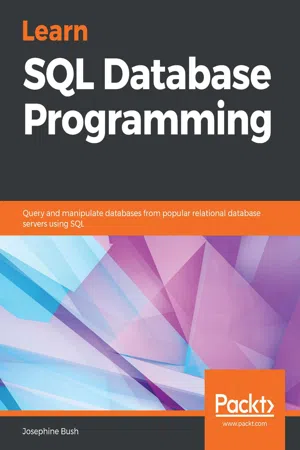
Learn SQL Database Programming
Query and manipulate databases from popular relational database servers using SQL
- 564 pages
- English
- ePUB (mobile friendly)
- Available on iOS & Android
Learn SQL Database Programming
Query and manipulate databases from popular relational database servers using SQL
About this book
Learn everything you need to know to build efficient SQL queries using this easy-to-follow beginner's guide
Key Features
- Explore all SQL statements in depth using a variety of examples
- Get to grips with database querying, data aggregate, manipulation, and much more
- Understand how to explore and process data of varying complexity to tell a story
Book Description
SQL is a powerful querying language that's used to store, manipulate, and retrieve data, and it is one of the most popular languages used by developers to query and analyze data efficiently.
If you're looking for a comprehensive introduction to SQL, Learn SQL Database Programming will help you to get up to speed with using SQL to streamline your work in no time. Starting with an overview of relational database management systems, this book will show you how to set up and use MySQL Workbench and design a database using practical examples. You'll also discover how to query and manipulate data with SQL programming using MySQL Workbench. As you advance, you'll create a database, query single and multiple tables, and modify data using SQL querying. This SQL book covers advanced SQL techniques, including aggregate functions, flow control statements, error handling, and subqueries, and helps you process your data to present your findings. Finally, you'll implement best practices for writing SQL and designing indexes and tables.
By the end of this SQL programming book, you'll have gained the confidence to use SQL queries to retrieve and manipulate data.
What you will learn
- Install, configure, and use MySQL Workbench to restore a database
- Explore different data types such as string, numeric, and date and time
- Query a single table using the basic SQL SELECT statement and the FROM, WHERE, and ORDER BY clauses
- Query multiple tables by understanding various types of table relationships
- Modify data in tables using the INSERT, UPDATE, and DELETE statements
- Use aggregate functions to group and summarize data
- Detect bad data, duplicates, and irrelevant values while processing data
Who this book is for
This book is for business analysts, SQL developers, database administrators, and students learning SQL. If you want to learn how to query and manipulate SQL data for database administration tasks or simply extract and organize relevant data for analysis, you'll find this book useful. No prior SQL experience is required.
Frequently asked questions
- Essential is ideal for learners and professionals who enjoy exploring a wide range of subjects. Access the Essential Library with 800,000+ trusted titles and best-sellers across business, personal growth, and the humanities. Includes unlimited reading time and Standard Read Aloud voice.
- Complete: Perfect for advanced learners and researchers needing full, unrestricted access. Unlock 1.4M+ books across hundreds of subjects, including academic and specialized titles. The Complete Plan also includes advanced features like Premium Read Aloud and Research Assistant.
Please note we cannot support devices running on iOS 13 and Android 7 or earlier. Learn more about using the app.
Information
Section 1: Database Fundamentals
- Chapter 1, Introduction to Relational Database Management Systems
- Chapter 2, Installing and Using MySQL Workbench
- Chapter 3, Understanding Data Types
- Chapter 4, Designing and Creating a Database
- Chapter 5, Importing and Exporting Data
Introduction to Relational Database Management Systems
- Understanding SQL
- Understanding databases
- Understanding data integrity
- Understanding database normalization
- Types of RDMS
Understanding SQL
- Use DDL commands to specify database schema:
- CREATE: This is used to create a new database or objects in a database.
- ALTER: This is used to alter a database or objects in a database.
- DROP: This is used to delete a database or objects in a database.
- TRUNCATE: This is used to remove all data from a table instantaneously.
- Use DML commands to query and modify data:
- SELECT: This is used to retrieve data from a database.
- INSERT: This is used to insert data into a database.
- UPDATE: This is used to update data in a database.
- DELETE: This is used to remove data from a database.
- Use DCL commands to control permissions and translations:
- GRANT: This is used to give access to a user.
- REVOKE: This is used to take access away from a user.
- COMMIT: This is used to save changes in a transaction.
- ROLLBACK: This is used to remove the saved changes in a transaction.
Table of contents
- Title Page
- Copyright and Credits
- About Packt
- Contributors
- Preface
- Section 1: Database Fundamentals
- Introduction to Relational Database Management Systems
- Installing and Using MySQL Workbench
- Understanding Data Types
- Designing and Creating a Database
- Importing and Exporting Data
- Section 2: Basic SQL Querying
- Querying a Single Table
- Querying Multiple Tables
- Modifying Data and Table Structures
- Section 3: Advanced SQL Querying
- Working with Expressions
- Grouping and Summarizing Data
- Advanced Querying Techniques
- Programmable Objects
- Section 4: Presenting Your Findings
- Exploring and Processing Your Data
- Telling a Story with Your Data
- Section 5: SQL Best Practices
- Best Practices for Designing and Querying
- SQL Appendix
- Assessments
- Other Books You May Enjoy